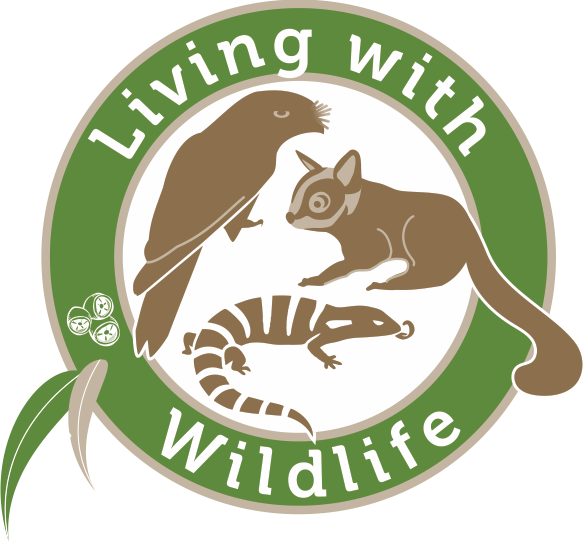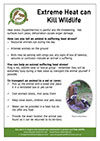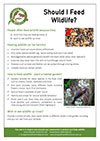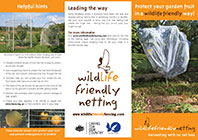Useful Information
Through our volunteer wildlife rescue, care and rehabilitation work we meet many people who would like to help wildlife but aren’t sure how. We also encounter wildlife displaced or suffering from injury and stress that could have been easily avoided. The following ‘Useful Information’ is provided to share good advice we have found and help others help and support the amazing wildlife we all share the environment with.
What to do if you find injured wildlife
If you find injured or orphaned wildlife it can be taken to a vet or wildlife carer at no charge.
If safe:
- pick up using a towel (cover face and claws) and place into a ventilated a box
- wrap a hot water bottle in a towel and place at one end so the animal can move away if too warm, use hot water from the tap only
- if you are unable to pick up or transport, contact your nearest wildlife rescue group or carer
- record the exact location where it was found
Remember wildlife will be frightened and likely in pain so keep them warm, dark and quiet. Please don’t pose them for photos, keep your pets away and keep the radio turned off in the car. Contact your nearest wildlife rescue group for assistance or advice.
AWARE Wildlife Rescue 0412 433 727 (Frankston and surrounding suburbs)
https://www.awarewildlife.org.au/
AEC (24hr Emergency Vet) 9770 5555
39 McMahons Road, Frankston
Department Environment, Land, Water and Planning (DELWP) (Victoria wide)
https://www.wildlife.vic.gov.au/injured-native-wildlife/help-for-injured-wildlife
Wildlife Victoria (Victoria wide)
https://www.wildlifevictoria.org.au/wildlife-information/report-a-wildlife-emergency
Download our ‘Heat Stress and Wildlife’ leaflet
Poisons and Wildlife
When we use poisons in our homes and gardens (such as on weeds, rats, insects and snails) wildlife can become the unintended target. They can die from the poisoning, be slowed down enough to be predated upon or get hit by cars. Poisoning can be either:
Primary poisoning –wildlife eat the poison directly
Secondary poisoning – wildlife eat other animals that have been poisoned such as mice, rats, insects or snails. Local carers treat many tawny frogmouths and kookaburras every year for secondary poisoning. These birds are part of the natural pest control system and are being poisoned by the very food source they are helping to control.
Avoiding chemicals at home can greatly assist the survival of wildlife.
Further reading
ABC News – Boobook owls falling victim to household rat poison, study finds
https://www.abc.net.au/news/2017-12-06/boobook-owls-victims-of-rat-poison-study-finds/9227944
The Conversation – Australia’s reptiles may be spreading rat poison through the food chain
https://theconversation.com/australias-reptiles-may-be-spreading-rat-poison-through-the-food-chain-94922?fbclid=IwAR3ln9u-zmkF2XC6zi5LOP-fuN6hfeBTYZenL87adhjQQGnnUF7tc2JeQas
Should I feed wildlife?
We feel that the best way to feed wildlife is to allow your garden to provide the food rather than use supplementary feed such as seed or mince. Planting a garden, including indigenous plants (local natives), will provide a variety of food for the nectar eaters, seed eaters and even meat eaters through the insects and other wildlife it attracts.
Download our ‘Should I Feed Wildlife?’ leaflet
Wildlife Friendly Gardening
Creating a wildlife friendly garden helps local wildlife species, supports biodiversity and is also good for your health. We suggest using indigenous plants to create a balanced garden to suit your soil and weather conditions. Many regions have a ‘Gardens for Wildlife’ program operating, check out www.gardensforwildlife.vic.com for resources and information.
Your local council and Sustainable Gardening Australia www.sgaonline.org.au will also have useful information and resources.
Recommended reading – Habitat, A practical guide to creating a wildlife-friendly Australian garden by A B Bishop and published by Murdoch Books
Wildlife friendly netting
Download a wildlife friendly netting brochure
Bees – Native and Introduced
Introduced bees are a threat to native wildlife, they out-compete other species for pollen and invade hollows needed for dens and breeding. Encourage native bees (there are over 1,700 species) instead of introduced bees and you will be supporting your local flora and fauna.
Article: Myth: Beekeeping is needed to conserve pollinator populations.
https://www.truthordrought.com/beekeeping-for-conservation-myths?fbclid=IwAR2AUAaZVyTnx3g9xQEkRTt-4s-ChrtuEWK-6zSBkclwPdnHd1Bqxh_JpRw
Facebook site – Bees in the Burbs (run by scientist Kit Prendergast)
https://www.facebook.com/groups/Beesintheburbs/
Pets and Wildlife
Local Australian wildlife, including marsupials, birds and reptiles, are unique and special and they evolved in an environment that did not include cats and dogs. There is overwhelming scientific evidence of the damage and threat our pets pose.
For the sake of wildlife please be a responsible pet owner by having areas wildlife can safely move through your garden, confining cats and only allowing your dog off-lead in designated areas.
Wildlife Challenges
Native animals are precious, unique and protected by law in Victoria. However, there are times when co-existing with them can present challenges such as swooping birds, possums making a home in your roof or protecting your fruit crop from birds.
For information and help to resolve these challenges go to Dept Environment, Land, Water & Planning www.wildlife.vic.gov.au/managing-wildlife
AWARE Wildlife Rescue www.awarewildlife.org.au and Wildlife Victoria www.wildlifevictoria.org.au also have useful information.
Nest Boxes and Old Trees
The loss of old trees has resulted in a lack of nesting sites for birds such as kookaburras, ducks, parrots and owls and a lack of denning sites for mammals such as micro-bats, possums and gliders. Hollow logs on the ground support insects and reptiles.
We can help wildlife struggling to find homes and breeding sites by installing a nest (aka habitat) box. There are many things to be aware of when choosing and installing a nest box. We use and recommend www.birdlife.org.au Nest boxes for Wildlife, a Practical Guide by Alan & Stacey Franks, The Nestbox Book, Gould League www.wildlifenestboxes.com.au.
NestBoxTales is a great facebook page to join for resources and networking.
https://www.facebook.com/groups/nestboxtales/
To best support wildlife retain old trees and fallen logs whenever possible.



